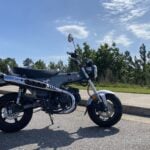A short-lived but ground-breaking motorcycle
The first time I ever beheld a Flying Merkel up close was at the Barber Museum in Birmingham, Alabama during the annual Vintage Festival they host every October. In a large side room where a Bonham’s auction would soon be staged, the bright orange machine arrested my attention, and I stood transfixed by this beautiful 100+ year old motorcycle. I’ve no idea what the bike later fetched on the auction block, but I’ve read they can go for well over $100K in good or restored condition. It’s easy to understand why, when the history of the brand is explored.
The Merkel that caught my eye at Barber.
The Merkel Motorcycle Company first opened its doors in Milwaukee, Wisconsin in 1902 when Joseph Merkel started building single cylinder motorcycles in a burgeoning market. The man was an avid innovator, pioneering many inventions that would become adopted/adapted by motorbike builders the world over- a spring front fork that would be the forerunner to today’s telescopic setups, a mono shock rear suspension, the use of ball bearings rather than bronze bushings within the engine, cam-actuated intake valves, and even a throttle-controlled engine oiler that Indian and Harley-Davidson would later utilize. Merkel was ahead of his time.
Perry Powell of Powell Brothers Motorcycles in Grand Island, NE, getting ready to test ride one of their race-prepped Flying Merkels in 1915. Photo by TheFlyingMerkel.com
In 1905 Merkel took to racing, and developed several bikes for competition across the company’s years. The brand was purchased in 1909 by the Light Manufacturing Company, and the whole operation relocated to Pottstown, Pennsylvania. Merkel developed more frame and suspension improvements, and produced the “Merkel Light” and soon the beloved “Flying Merkel” machines. A young racer named Maldwyn Jones joined the crew, and went on to win multiple national races on a Flying Merkel. Their name and fame was spreading.
Merkel factory test rider/racer Maldwyn Jones on track. Photo by TheFlyingMerkel.com
In 1911 the Miami Cycle Manufacturing Company purchased Merkel, and again production relocated, this time to Middleton, Ohio. Miami Cycle had been manufacturing bicycles and motorbikes since 1895, so their experience and capital pushed Merkel into new territory as a premier moto brand. Their factory racing team won the coveted National Endurance Race from Chicago to St. Louis in 1914, and Jones himself broke a world record on the famous Vanderbilt race course that same year.
Flying Merkels living up to their name on track. Photo by TheFlyingMerkel.com
Sadly, history and world events intervened. World War I drew in the United States, first in aiding and supplying Allied countries, then militarily by 1917. In a shrinking wartime market, with increased competition from Harley-Davidson, Indian and others, production at Merkel faltered. By 1917, the once highly touted brand abruptly closed its doors, ceasing production and closing the books on a short but storied run. Joseph Merkel himself had already departed the company, so maybe its doom was inevitable.
The pristine 1916 Flying Merkel at the Throttlestop Museum in Elkhart Lake, WI. Photo by Throttlestop.
Yet the legend of this brief but bright motorcycle brand has lived on, however rare the bikes are to find these days. Merkel’s innovative designs, the machines’ outstanding engineering for their time, their racing prowess, and that evocative name and logo (not to mention their bold orange paint) all combine to make them iconic classics, distinguishable from every other motorcycle one could lay eyes upon today. The Throttlestop Museum in Elkhart Lake, Wisconsin has a beautifully restored one in their collection, and it’s a stunner to see. Check it out via their virtual museum on their website (link below), or up close and personal if you’re ever up that way for races or events at Road America.
Rob
*info and photos sourced from TheFlyingMerkel.com, ThrottlestopMuseum.com, and Wikipedia Commons.






























0 Comments